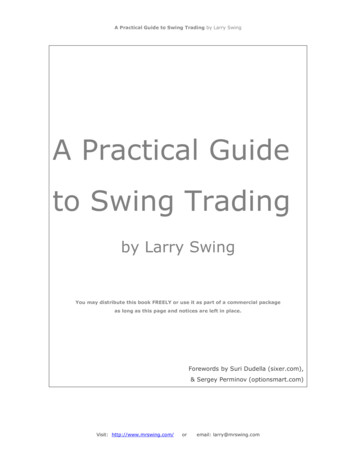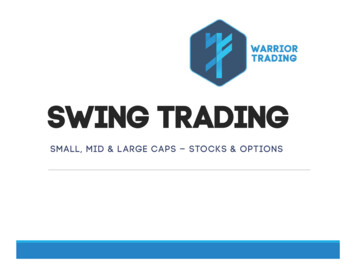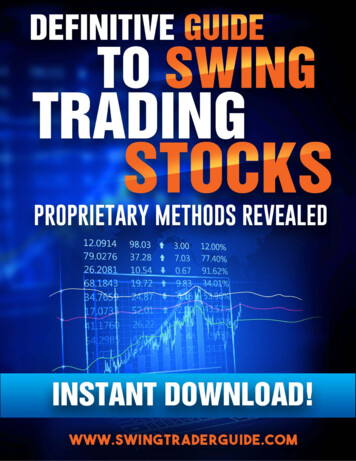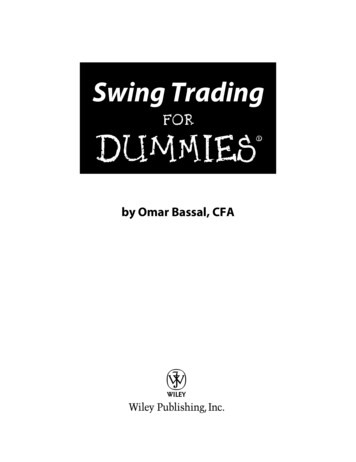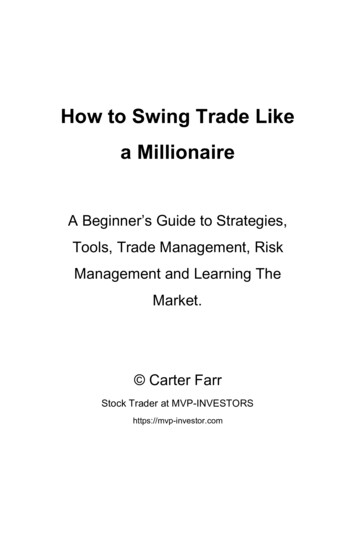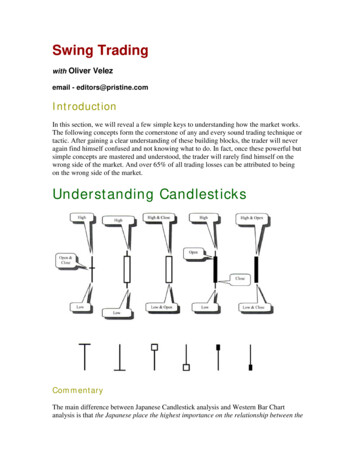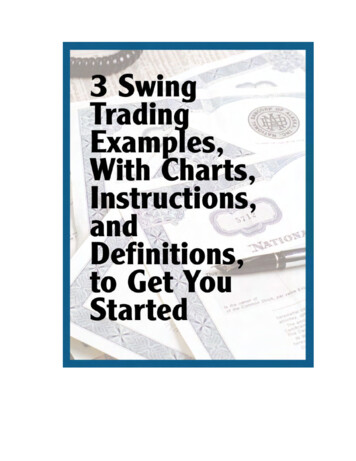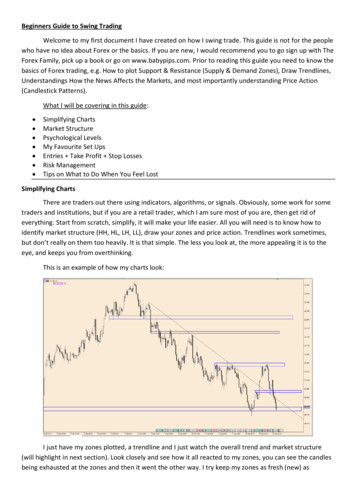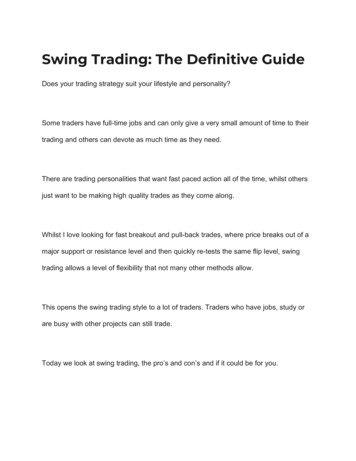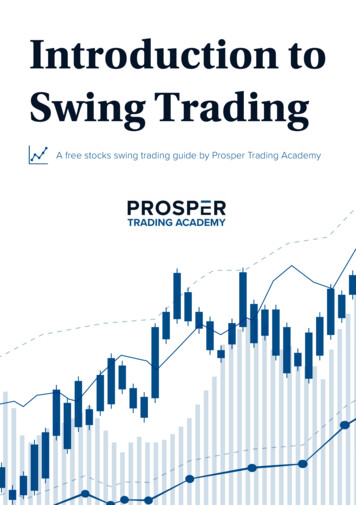
Transcription
Introduction toSwing TradingA free stocks swing trading guide by Prosper Trading Academy
Introduction to Swing TradingA Stocks Swing Trading GuidebyProsper Trading Academy&Dan O’Brien
DAYTRADING involves high risks, and YOUcan LOSE a lot of money. Hypothetical orsimulated performance results have certaininherent limitations. Unlike an actualperformance record, simulated results do notrepresent actual trading. Also, because the tradesactually have not been executed, the resultsmay have under-or over-compensated for theimpact, if any, of certain market factors, suchas lack of liquidity. Simulated trading programsin general also are designed with the benefitof hindsight. No representation is being madethat any account will or is likely to achieveprofits or losses similar to those talked aboutin our site. The information contained hereinis specifically for the limited personal use ofthe individual who purchased this course. Anyreproduction, dissemination or retransmissionof the information contained in this course isstrictly prohibited without the express writtenpermission of Prosper Trading Academy LLC. 2017 Prosper Trading Academy
About the AuthorDan O’BrienSenior Stocks Instructor,Prosper Trading AcademyDan O’Brien has had a long, experienced career as a trader, a brokerand an educator. He has a tremendous track record calling tradingsignals in the E-Mini S&P 500. Dan has developed all the tools with hisover 20 years’ experience in the business - top-notch technical acumen,an in-depth understanding of market fundamentals, a disciplinedapproach to trading and a patientstyle of teaching.
Introduction to Swing TradingThe vast majority of people with money in the market viapension funds, mutual funds and other ways, just don’t paymuch attention to the different types of trading that areavailable to them. When the average person thinks of thestock market, he thinks of buying shares of a mutual fundand forgets about the rest. He tells himself, “I’m a long-terminvestor. Buy and hold is for me.” Although that is fine for aportion of his overall investment, he fails to realize that thereis more to investing, like day trading or trend trading. Butfor someone who is already a very long term investor anddoes not have the time to sit in front of a computer screenall day, perhaps the middle ground is were he can reallyincrease his overall returns using swing trading techniques.From bankers to private trading firms to the average Joe,people actively participate in the markets everyday it isopen. Whether one is a day trader, a swing trader, or longterm investor, speculators provide the necessary liquidityto create an actual market. These traders attempt to profitfrom price changes due to earnings reports, supply anddemand changes, or certain news that they believe will causefluctuations in a stock price.So what is swing trading and how is it different from daytrading and long term investing? Let’s start with the easyone - long term investing. Almost all long term investorsare those that just buy and hold. No matter what happens,they’re not moving a muscle to help themselves, even when1
the market is falling. However, there are some firms, usuallyhedge funds or RIAs, that short stocks for long periods oftime, but they are rare indeed. For example, investor JimChanos gained fame when he predicted that Enron wouldfile bankruptcy long before it happened and that his firm,Kynikos, was short the stock. He held it for the longterm; all the way to the bottom price of zero.On the other end of the spectrum are day traders, and theyare looking for brief opportunities every day to either buyor sell in multiple stocks. The day trader will be out of allof his positions before the close of the market the sameday. Day traders have special rules set up by governmentregulators. From FINRA, we read the following:The rules adopt the term “pattern day trader,” which includesany margin customer that day trades (buys then sells or sellsshort then buys the same security on the same day) four or moretimes in five business days, provided the number of day trades aremore than six percent of the customer’s total trading activity forthat same five-day period. Under the rules, a pattern day tradermust maintain minimum equity of 25,000 on any day that thecustomer day trades. The required minimum equity must be in theaccount prior to any day-trading activities. If the account fallsbelow the 25,000 requirement, the pattern day trader will not bepermitted to day trade until the account is restored to the 25,000minimum equity level.The rules permit a pattern day trader to trade up to four timesthe maintenance margin excess in the account as of the close of2
business of the previous day. If a pattern day trader exceeds theday-trading buying power limitation, the firm will issue a daytrading margin call to the pattern day trader.So if someone does not want to deal with the rules laid outabove, but also wants to be more active than a buy and holdinvestor, swing trading may be right for them. Simply put,swing trading is a medium-term strategy that traders use tocapitalize on the price “swings” of stocks, usually over theperiod of a few days to perhaps a few weeks. This tends towork for individuals and not institutional traders because thelatter are making very large bets on the price of the stockthat may take days to complete, and are meant to be heldfor very long periods of time. This activity, however, is oftenwhat creates the swing trading opportunities for the individualtrader.At Prosper Trading Academy, we believe that the bestcompanies to swing trade should have high daily tradevolume. It would be a good idea to only focus on those stocksthat trade at least a minimum of one million shares per day,while others may decide to use a rule of several multiples ofthat. Swing traders focus on these stocks because their pricesoften move in one direction for several days in a row. What’smore, since the volume is high, they will have no problemfilling their orders. Some stocks that have these characteristicsare Apple, Amazon, and Facebook to name just a few.Prosper Trading’s students use a systematic approach to the3
markets; they are not looking at a company’s balance sheetor next quarter’s sales projections, for example. Our swingtraders are technical traders, which means that they maketheir decisions by what they see and use on the charts: trendlines, moving averages, pattern recognition, volume, etc. Swing traders do not care about fundamentals. Swing traders don’t care much for analyst projections. Swing traders don’t even care what the company sells. They’re just looking forgood movement on a regular basis.Below is a chart of US Steel, symbol X. Here is an exampleof a chart based potential trade. The technical informationshows a few moving averages that are bullishly sloping up, atrailing stop program that is bullishly supporting the market,and high daily volume. The horizontal yellow line is onan old price level that defines an area that could lead to abreakout to higher prices. Because of this, the lowest greenoval is where a swing trader may look to initiate a series oflong positions if it does breakout.With the concept in mind that a swing trader normally holdsa position 3 to 5 days, you can see that the breakout levelrallied the stock for 5 days and then fell to support. The 2ndgreen buying oval led to another 5-day rally, which then ledto a week long sideways move. The final green buying ovalresulted in another 5-day breakout to higher prices.4
As you can see in the example above, when the swing traderhas exited his position after 5 days, US Steel went lower orsideways, thus not adversely affecting the swing trader sincehe was flat. It doesn’t always work out that symmetrically, butsymmetry is not the point - the point is to hit the fast swingand then profit. After all, the market can always violentlyreverse, which leads me to another important point of swingtrading: going SHORT.Since a swing trader is never “always in the market” he hasthe ability to identify weakness in a sector or specific stock5
and actually profit as it falls. As of this writing, GE is gettingbattered. More specifically, buy and hold investors aregetting battered! Swing traders, however, can take advantageof the weakness by shorting the red ovals and buying back3 to 5 days later in the lower green ovals. The first greenprofit target was drawn 8-9 days later because the downsidemomentum was overwhelmingly bearish, which would keep aswing trader in the market longer than normal.Another important aspect for any swing trader should berisk management and position sizing. At Prosper TradingAcademy, however, we demand it. Why? If you do not knowexactly what size you should put on and where you will exitif you are wrong, then you are doomed to failure. Swingtrading will not always yield perfect entries and exits, so youmust be prepared for losses.6
Using Prosper Trading’s scientific position sizing method, youwill know the exact amount of shares that should be used andthe exact stop-loss level that will be used. There will be NOguessing!Is swing trading right for you? At Prosper Trading Academywe encourage everyone to find their niche environment. Ifyou can not sit at the computer screen all day for day trading,or simply do not have the skill for that, perhaps swing tradingis for you. You may think that trend trading is the answer andperhaps it is, but that takes discipline too - discipline to stay ina position for longer periods of time and ride out the adverseprice action. Can you do that or would you rather pocket thecash?Ultimately you must make that decision, but swing tradingmay be a great place to start and all of the pro’s at ProsperTrading Academy will do everything to help you make theright choice.To learn more about the swing trading stocks and othermarkets like penny stocks, cannabis, and cryptocurrenciesemail us ing.com/7
day-trading buying power limitation, the firm will issue a day-trading margin call to the pattern day trader. So if someone does not want to deal with the rules laid out above, but also wants to be more active than a buy and hold investor, swing trading may be right for them. Simply put, swing trading is a medium-term strategy that traders use to
